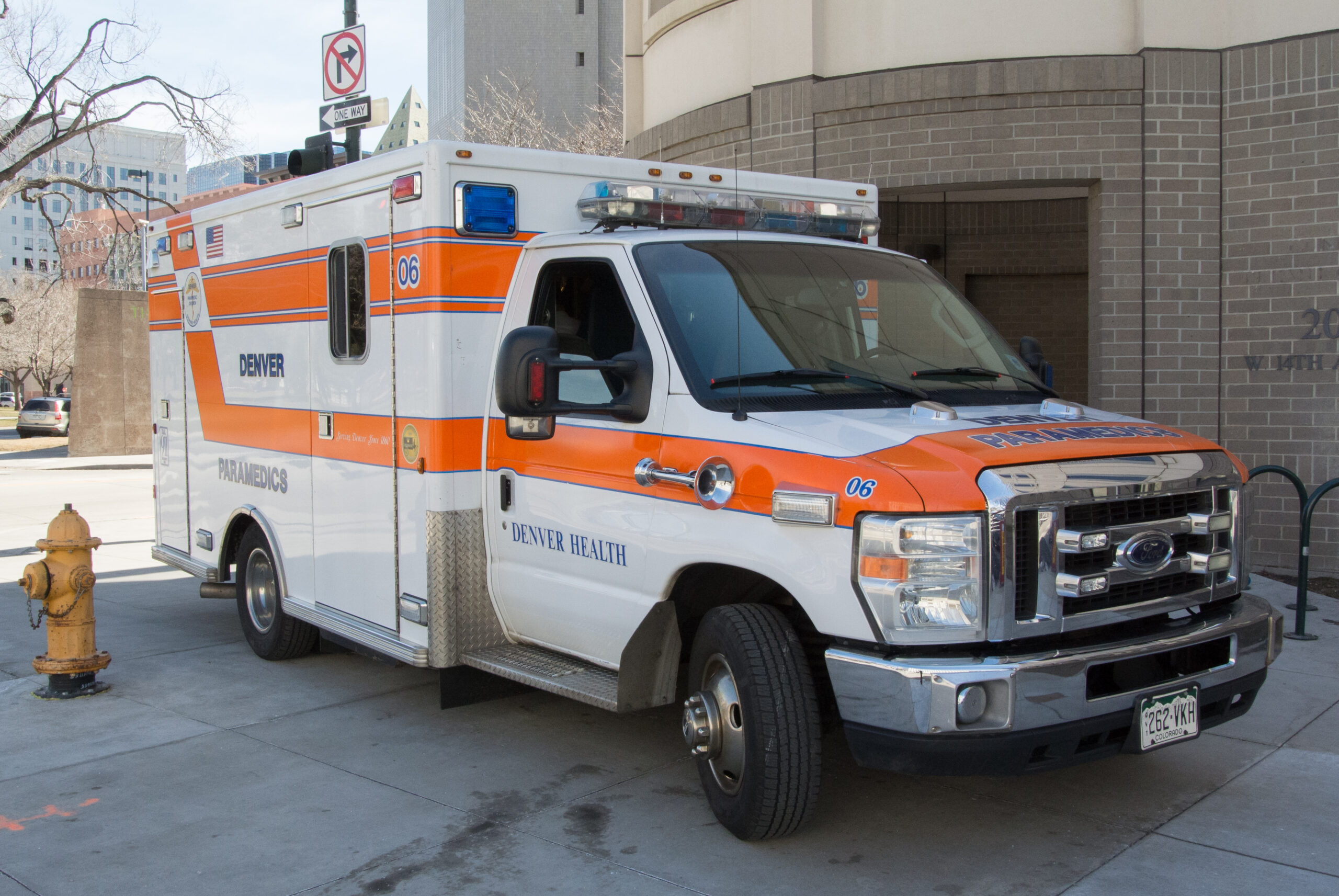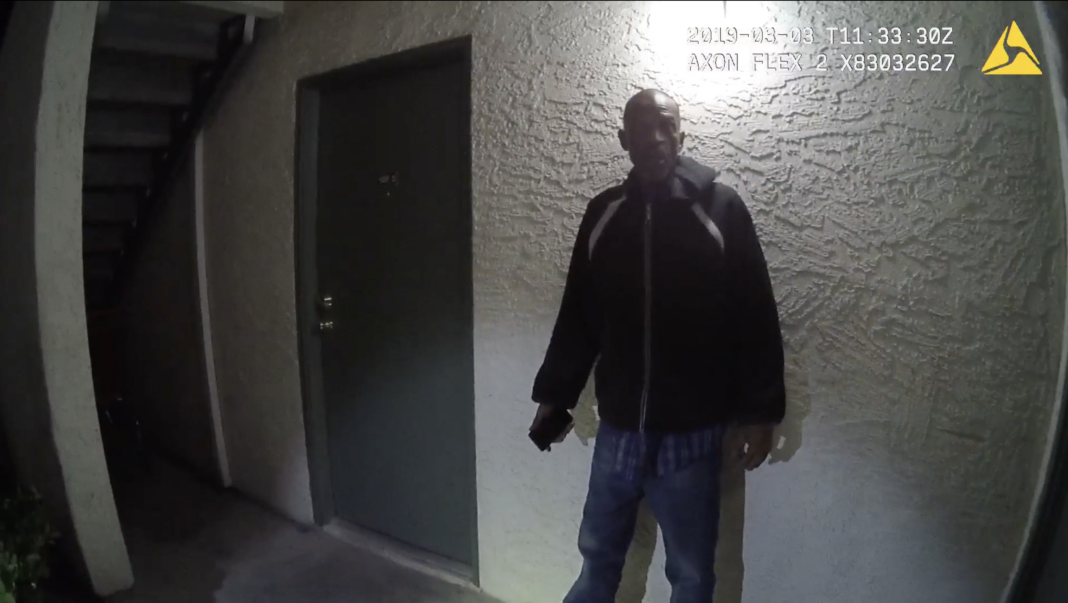
LAS VEGAS – On a chilly morning in 2019, just after 3 a.m., Roy Anthony Scott called 911 to report that a group of people – one armed with a saw – was trying to break into his apartment.
This wasn’t the first time a dispatcher had sent emergency responders to Scott’s home in Sunset Gardens, a senior living complex in Las Vegas. Seven other 911 calls had been placed from his apartment over the previous year, logs from Las Vegas Fire & Rescue show, including one just hours before the call about the attempted break-in.
A neighbor and relative said ambulance crews typically responded to Scott’s calls because of his known health conditions. An incident report from Scott’s second-to-last call said he complained of chest pain and had a history of psychiatric issues, stroke and diabetes. The case was closed in just 18 minutes, records show.
But in the pre-dawn hours of March 3, 2019, it was two Las Vegas Metropolitan Police Department officers answering the call; Kyle Smith and Theodore Huntsman, who were working their first shift together.
The officers knocked on Scott’s second-floor apartment door and asked him to come out, but Scott insisted the intruders were now inside his apartment and asked police to kick in his door, body-camera footage shows.
Instead, the officers shined a flashlight through Scott’s apartment window. They later testified they saw a man standing alone, looking off with a “thousand yard stare.”
When Scott eventually left his apartment, police said he came out holding a long, thin metal pipe and a cellphone. Smith drew and pointed his gun at the 65-year-old Scott saying, “put that down.” Scott immediately dropped the pipe and slowly descended the complex’s stairs.
Scott also gave officers a steak knife from his waistband. But when police asked him to turn around for a pat-down, Scott refused and said he wasn’t comfortable because he had paranoid schizophrenia.
As the officers became insistent, Scott became more agitated, at one point asking to be put in the back of the police car, instead. Body-camera video showed the officers trying to handcuff Scott and the three men falling to the ground.
Officers then turned Scott facedown onto his stomach and pressed the weight of their bodies and gear against him for over 90 seconds while struggling to put on the handcuffs before they rolled him onto his back and side, according to police body-camera video. Throughout Scott repeatedly begged the officers to please stop and to be left alone.
While on his side, police officers said they noticed Scott was faintly breathing. One of the officers radioed dispatch, saying Scott was potentially suffering from excited delirium, according to an investigative report by Las Vegas police.
Police left Scott lying on his side on a patch of sidewalk and gravel in front of the complex for nearly 10 minutes before paramedics arrived and told police to uncuff him. Once in the ambulance, paramedics started CPR on Scott, but it was too late. He was pronounced dead at the hospital a short while later.
The medical examiner’s report said Scott’s death was an accident caused by methamphetamine intoxication and not police restraint.
“My dad, he needed help. He didn’t need to be apprehended, handcuffed, he needed help,” said his daughter, Rochelle Scott, 45. “He didn’t deserve to go out – no one deserves to go out like that – like a dog in the street.”
“They made him look like a monster, like he was just this dopehead and nobody cared and loved him,” she added. “That was not the case.”
Rochelle Scott had been planning to get married, with her dad walking her down the aisle. Instead, she filed a wrongful death lawsuit in October 2020 against the officers and the Las Vegas Metropolitan Police Department on her father’s behalf.
A judge in March 2023 found that the force officers used against Scott was unconstitutional, especially given that he had not committed a crime or threatened harm to the officers or himself beforehand. The judge also rejected officers’ claims that they were entitled to qualified immunity, a legal doctrine that provides protections from lawsuits for police and other government officials. Attorneys for Smith and Huntsman did not respond to a request for comment but have appealed the judge’s ruling to the 9th U.S. Circuit Court of Appeals, which is pending.
Contested term obscures risks
The term “excited delirium” has been around since the 19th Century, but the first modern usage came in the 1980s when a Miami-Dade county medical examiner sought to explain the sudden deaths of Black people, typically in police custody, who had used cocaine. Dr. Charles Wetli used excited delirium to explain the deaths of more than a dozen Black women around Miami, arguing that the interaction of cocaine use and sexual intercourse killed them.
But in 1992, police announced that a serial killer was actually responsible for the deaths, and Wetli’s boss, chief examiner Joseph Davis, “exhumed the bodies for re-examination and found evidence of asphyxia,” according to reporting from the Miami New Times.
Despite this history, the term gained traction among police and medical examiners.
Groups like Physicians for Human Rights have called for the complete retirement of the term, arguing it has racist origins and that some of the symptoms perpetuate stereotypes of people of color, such as “superhuman strength” and greatly increased pain tolerance.
Other groups — such as the American College of Emergency Physicians and the National Association of Medical Examiners — have also recently come out against the term. And in February 2023, California became the first state to ban excited delirium from being recognized as a “valid medical diagnosis” or listed as a cause of death on autopsies and death certificates.
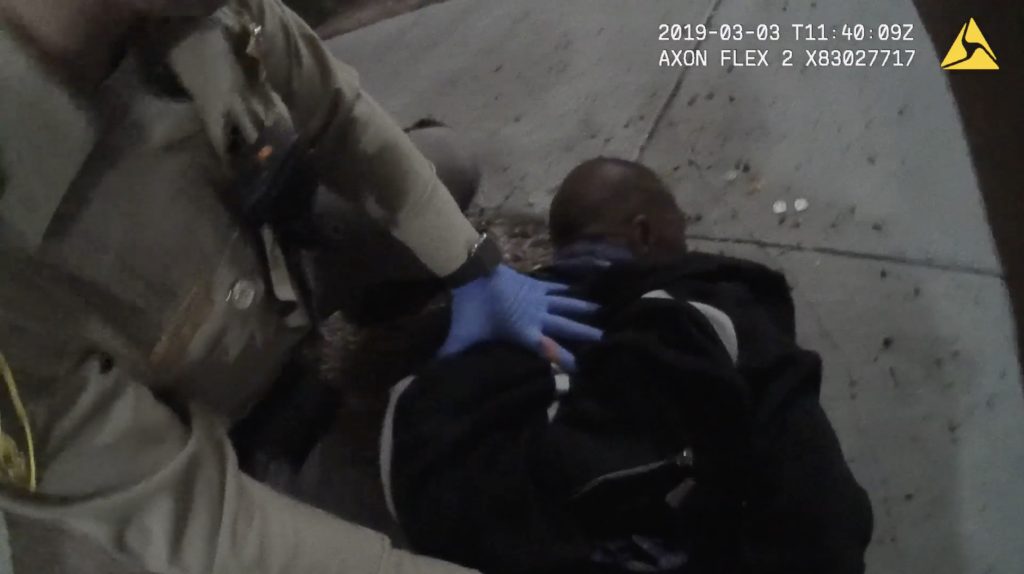
The Las Vegas Metropolitan Police Department does not have training specifically for meth-induced crises. But it does have a policy on “Responding to Persons in Behavioral Crisis or with Special Needs” that identifies excited delirium as an “acute, excited state” that is “usually associated with illicit or prescription drug use and manifested by behavioral and physical changes that may result in sudden and unexplained death.” It says those experiencing excited delirium “should be considered in medical crisis.”
According to the policy, signs of excited delirium include “elevated body temperature, profuse sweating, dilated pupils, uncontrollable shaking, talking incoherently, yelling, paranoia,” extreme aggression or violent resistance, “inappropriate shedding of clothing, or self-inflicted injuries.”
But some criminology and medical researchers question the reality of excited delirium and how the police approach subjects in crisis.
“It seems to be such an easily used, undefined, unscientifically validated term that I just don’t buy it,” said Frank Rudy Cooper, a professor of law at the University of Nevada, Las Vegas and the director of the school’s Program on Race, Gender and Policing. It’s “a nice term to hang on anybody who the police were really aggressive with, as to combat the idea that they were using excessive force.”
Since 2014, the Las Vegas Metropolitan Police Department has put all new recruits through 36 hours of Crisis Intervention Team training to help them manage situations with mentally ill people, as well as those believed to be suffering from excited delirium. If faced with excited delirium in the field, the training advises officers to formulate a custody plan and quickly gain control of the person. The procedures also advise officers to call for medical help, quickly turn subjects onto their side after subduing them so that airways aren’t constricted and monitor their breathing.
Required training is subject to self-reporting by police departments to Nevada Peace Officer Standards and Training, after which an audit is conducted to ensure officers have done the training. But according to POST Executive Director Mike Sherlock, the agency is only looking for a certification of completion and is not evaluating the curriculum of these training sessions or how they are taught.
The best way to handle people acting erratically as a result of mental illness or drugs has been a major topic of discussion in policing circles. Two months before Scott’s death, police personnel and researchers gathered at a conference at the behest of the Los Angeles Police Department to discuss how less-lethal weapons and tactics can play a role in such encounters. The conference findings were published in a 54-page report by the Police Executive Research Forum, a leading policing think-tank based in Washington, DC.
“Officers should take cover, keep a safe distance, slow the situation down, call for additional personnel and resources, and above all, think carefully about the situation they are facing,” the report advised. The goal should be to use critical thinking and tactical communication skills to deescalate the situation so that no use of force is necessary.
“Success is more likely to be achieved through voluntary compliance,” the report found.
The officers who responded to Roy Anthony Scott’s call for help had been trained in crisis intervention the year before, according to their training logs, obtained via court records. Under questioning during his deposition, Huntsman acknowledged that “thousand yard stare” could indicate “both someone who is mentally ill and high on narcotics.”
Peter Goldstein, the attorney representing Scott’s daughter, said training programs don’t always mean officers are properly trained.
“They didn’t appear to learn the training because they didn’t recognize things that were readily apparent,” he said in an interview.
He also noted the officers left Scott facedown on the ground after grappling with and handcuffing him and added: “He wasn’t going to walk down the street that day and die of methamphetamine if nobody touched him.” Body-camera footage from Huntsman showed Scott was lying on his side with his face and chest leaning closer to the ground.
The officers
In a sworn deposition that Smith gave as part of Rochelle Scott’s lawsuit, the officer said the information he received from dispatch while en route to her father’s apartment was “very minimal.” When asked about the pre-planning of Smith and Huntsman’s interaction with Scott, Smith recalled feeling like “we’re not sure exactly what we’re coming into.”
While it was the first time the two officers worked together, Smith testified it was not his first encounter with Scott. According to 911 dispatch records, he helped a fellow officer in January 2019 detain Scott, after someone reported “a suspicious person that was acting in an agitated manner” outside a supermarket. Las Vegas Metropolitan Police told the Howard Center there were “no responsive records” related to this.
Huntsman was hired by the Las Vegas Metro Police Department in August 2017 and had worked as a construction worker and ophthalmology technician before joining the force, he said in his deposition. Smith joined the Las Vegas police force in September 2017 and had previously worked in retail at stores that sold hunting and outdoor goods and guns.
Little else is known about the officers’ background or job performance. The Howard Center filed a public records request for any incident reports involving use of force for Smith and Huntsman; their personnel records are not subject to release under Nevada law.
The police department refused to release any records, calling the request “vague and overbroad.” The department said it keeps different information related to such incidents on various databases and is not obligated to compile use-of-force incident reports.
Fatal call
When the 911 operator picked up the phone early on the morning of March 3, 2019, he asked: “Do you need police, fire or medical?” Scott did not reply. After giving some basic information, including his address and apartment number, Scott nervously pleaded with the operator to hurry because “they’re coming up my stairs.”
When the 911 operator asked who “they” were, Scott explained he did not know. Amid Scott’s pleas for assistance, the operator continuously asked what the group of people were doing on the stairs and who they were. “Man, you don’t care, do you?” Scott replied to the operator’s questions.
“I do [care], I just need to know what’s going on,” the operator said. “Do you know these people? How do you know they’re coming to your house?”
According to the 911 audio, Scott continued to accuse the operator of not caring about him as the operator heard what sounded like someone rummaging through the apartment in the background. The operator continued to try to extract information from Scott, asking how he knew this group of people were attempting to enter his apartment.
“Because they’re outside the goddamn door, man!” Scott replied. “They’ve got a f*cking saw.”
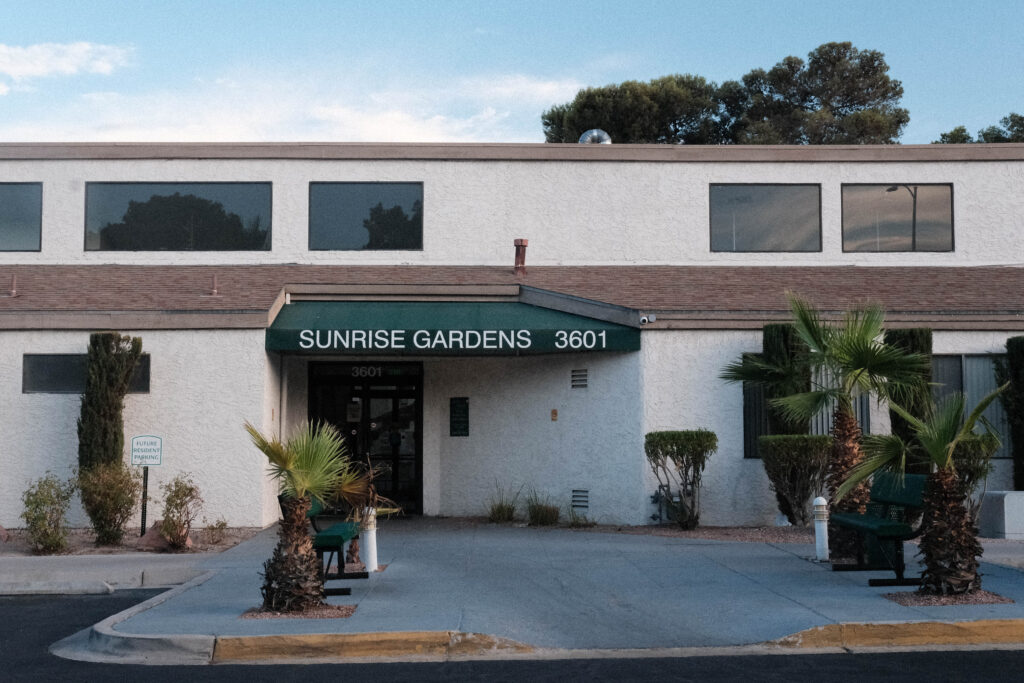
Emergency operators must simultaneously assuage a sometimes panicked caller and extract information from them in order to assess the situation. In certain cases, this juggling act can contribute to violent or lethal on-scene interactions between police and civilians, according to Jessica W. Gillooly, an assistant professor at Suffolk University in Boston.
A 2020 article in Criminology & Public Policy by Gillooly, who researches the role of 911 in the criminal justice system, said 65% of officer-involved shootings in the Las Vegas Metropolitan Police Department from 2007 to 2011 started with a 911 call, compared to 25% of shootings that were from officer-initiated contact.
“How do call takers potentially affect police outcomes? I think through priming them for the type of incident that they’re going to be responding to,” Gillooly told the Howard Center.
Gillooly said some operators take a more alarmist stance by flagging an incident as requiring a more urgent response. This kind of primed response based on 911 information translates to faster response time and, as Gillooly noted in her 2020 study, can result in arrest and the use of force.
“I found that the police who were responding to the more alarmist call-taker were more likely to code the call as higher priority at the scene,” Gillooly said.
The communications office of the Las Vegas Metro police department receives both emergency, such as 911, and non-emergency calls. From there, the operator gets information about the call and decides whether to assign it to police, fire, medical, or other agencies.
Operators, or call-takers, gather basic information from emergency calls, while dispatchers relay that information to a responding team. Smaller 911 centers usually have operators who also act as dispatchers, Gillooly explained, while larger centers typically split the roles.
“If it’s a separate position, they (dispatcher) don’t usually ever hear what the caller said. They’re just reading notes about that call that the call-taker typed into the computer, right?” Gillooly told the Howard Center.
The Las Vegas police department splits the roles of operators and dispatchers. In the case of Scott’s last 911 call to police, the operator and dispatcher classified Scott as a mentally ill person who became disconnected from the operator, but did not mention that Scott had a history of stroke and diabetes.
Alternatives to police responses
Michael S. Scott, director of the Center for Problem-Oriented Policing and a clinical professor in the School of Criminology and Criminal Justice at Arizona State University, has more than 40 years of experience in policing. He has concerns that many subjects in drug-induced crises will not respond to crisis intervention training, because psychosis clouds their thinking.
“At least from what I’ve seen, efforts to try to reason with the individuals to calm them down to get them to respond rationally simply don’t seem effective,” said Scott. “So the best you can hope for is to get them safely under control, safely to medical care. And cross your fingers and hope that the medical personnel can save their life.”
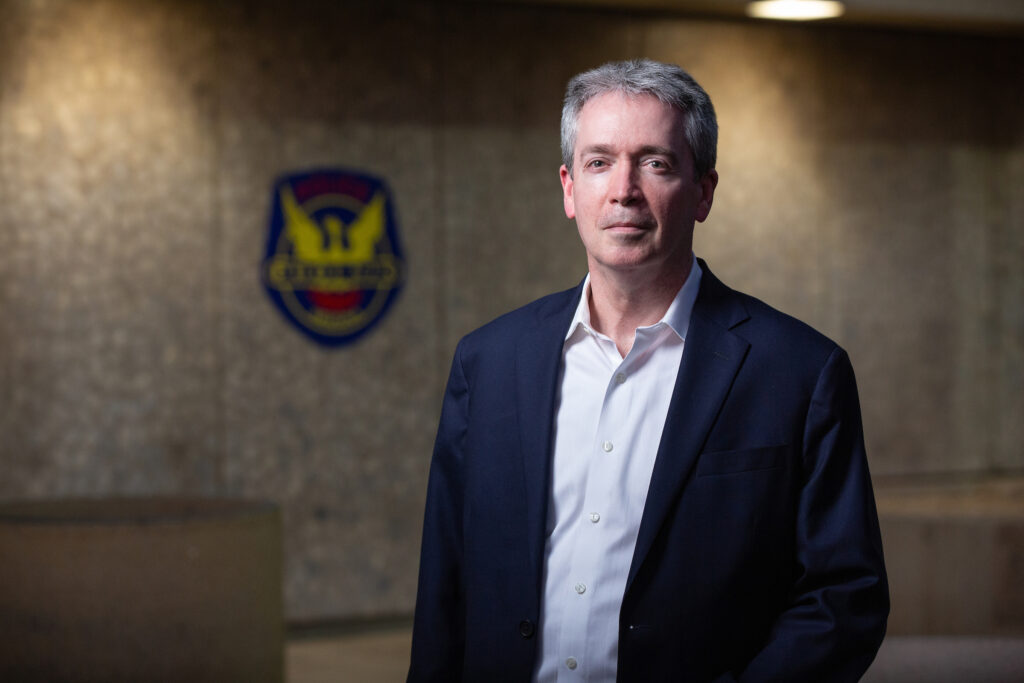
According to James Walsh, a Seattle-based addiction doctor, standard medical training when dealing with someone on stimulant drugs advises against restraining them, unless there’s no other way to administer medicine that might be necessary in a hospital setting.
“The treatment is not physical restraint,” Walsh said. “You don’t want to restrain them because restraint then adds danger.”
Given the problems with restraint, the emphasis on compliance for police and the acknowledgment that people in these drug-induced states are in medical crisis, some municipalities are looking at other responses.
In July 2022, Nevada joined a nationwide effort and launched a dedicated behavioral crisis hotline. The goal of the 988 hotline is to “divert” behavior and mental crisis calls from law enforcement to health professionals.
Before 988, “the only outlet we had to send to someone in a behavioral health crisis was law enforcement,” said Rachelle Pellissier, executive director of nonprofit Crisis Support Services for Nevada, which takes 988 calls.
“That’s why mental health and suicide is so stigmatized because we’ve treated them like criminals, because the only people we call when there are (mental) crises are police,” Pellissier said.
For Rochelle Scott, the police response to her father’s medical crisis changed her life forever. He was her last living parent.
“I never got married. My dad was supposed to walk me down the aisle,” Scott said in an interview. “I just haven’t been in that state of mind.”
Reporters Rachel Konieczny and Taylor Stevens contributed to this story, which was produced by the Howard Center for Investigative Journalism at Arizona State University’s Walter Cronkite School of Journalism and Mass Communication. The Howard Center is an initiative of the Scripps Howard Fund in honor of the late news industry executive and pioneer Roy W. Howard. Contact us at howardcenter@asu.edu or on X (formerly Twitter) @HowardCenterASU.
